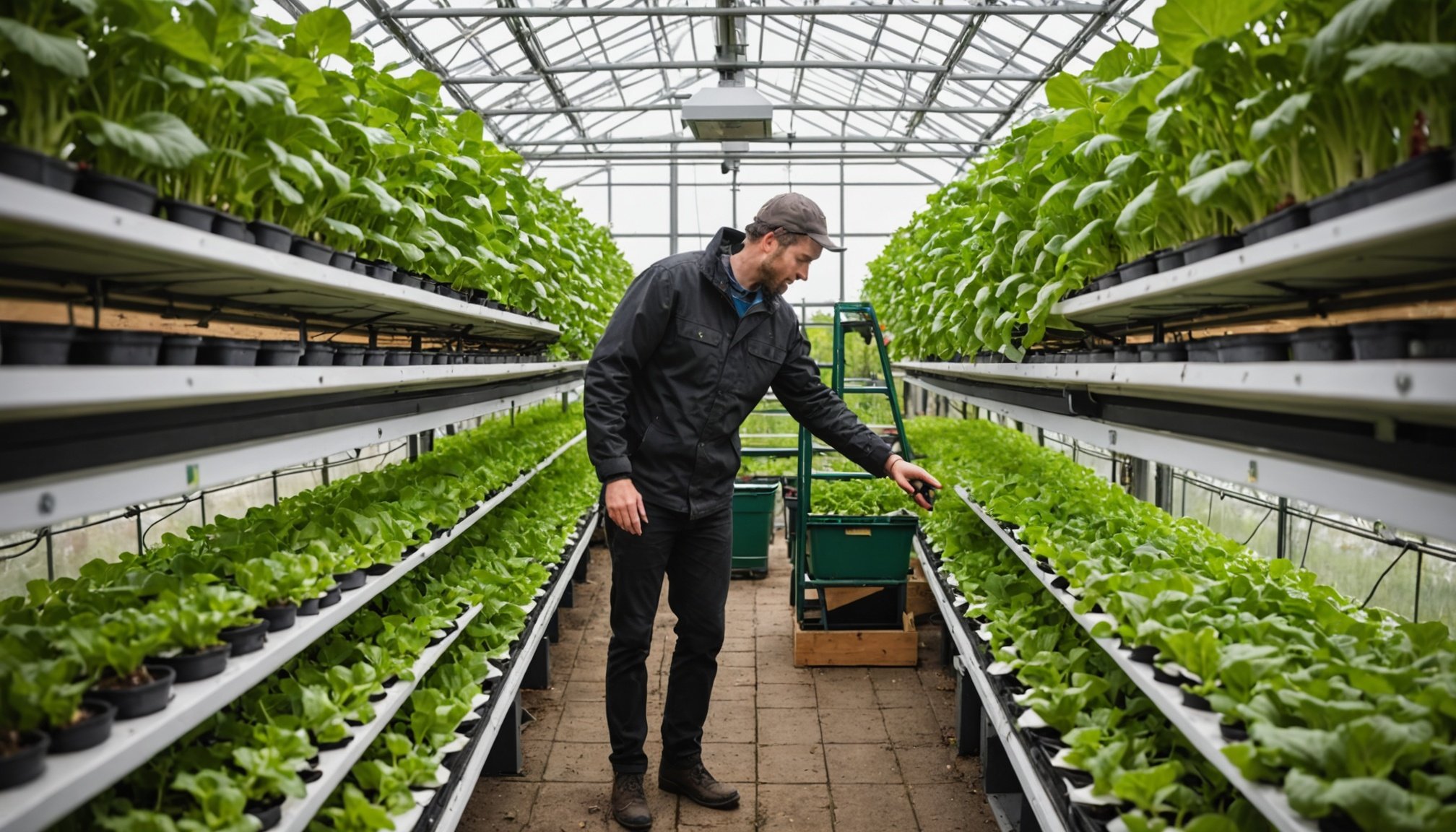Understanding Vertical Farming
Vertical farming is an innovative agricultural method that allows for plant cultivation in vertically stacked layers, often integrated into other structures like a building. This technique revolutionises traditional agriculture by maximising space efficiency, making it especially suitable for urban areas and small spaces where land is limited. By utilising vertical farming, individuals and communities can engage in home gardening methods that promote local food production.
A significant advantage of vertical farming is its commitment to sustainability. Unlike conventional farming, vertical farming reduces water usage and lessens the reliance on pesticides and herbicides, contributing to eco-friendly practices. The controlled environment also enables year-round crop production, reducing transportation emissions associated with seasonal produce importation.
Topic to read : Enjoy Warmth and Save on Energy: The Ultimate Guide to Eco-Friendly Underfloor Heating
The space efficiency of vertical farming cannot be overstated. In urban settings, where outdoor land is scarce and expensive, transforming indoor areas into productive gardens becomes a reality. This home gardening method supports fresh produce availability, enhances food security, and encourages urban dwellers to participate in sustainable agricultural practices.
Vertical farming, thus, stands as a transformative method with the potential to meet growing food demands while preserving environmental integrity.
This might interest you : Building a safe haven: your ultimate guide to allergy-resistant nursery materials and filters
Essential Equipment for Home Vertical Farming
Creating an effective home vertical farm requires an understanding of the vertical farming equipment essential for success. These include various growing systems like hydroponics, aquaponics, and aeroponics. Each comes with unique benefits; hydroponics is widely favoured for its water efficiency, while aquaponics integrates fish farming, adding complexity. Aeroponics, on the other hand, offers space-saving advantages but may require more advanced setups.
Growing Systems and Techniques
-
Hydroponic Systems: Use nutrient solutions instead of soil, conserving water and allowing direct nutrient absorption. They’re suitable for urban spaces with limited soil availability.
-
Aquaponic Systems: Combine hydroponics with aquaculture, recycling fish waste as nutrient-rich water for plants. It necessitates balancing fish and plant needs, making it intricate but rewarding.
-
Aeroponic Systems: Suspend plants in the air and mist nutrients directly onto roots, optimizing space efficiency. Ideal for small spaces, though these systems tend to be on the pricier side.
Choosing the right system hinges on your space, budget, and home gardening method preference. Investing time in understanding each system’s demands and benefits ensures a well-functioning vertical farm that maximises sustainability and productivity.
Lights and Environmental Controls
Proper lighting and environmental control are crucial for a successful home vertical farming setup. Without sunlight, grow lights become essential. Several types of grow lights exist, each serving different needs. LED lights are energy-efficient and produce low heat, making them ideal for small spaces. Fluorescent lights are affordable and easy to set up, but may not last as long. High-Intensity Discharge (HID) lights offer powerful illumination but generate significant heat and consume more energy.
Environmental factors like temperature and humidity are equally important. Excessive heat or humidity can damage plants, while too little can obstruct growth. Therefore, monitoring equipment, such as thermometers and hygrometers, becomes indispensable. Some sophisticated systems might incorporate smart controllers for automatic regulation.
Control systems are pivotal in optimising growing conditions. Advanced setups often use automated climate control systems that adjust settings based on the crop’s requirements. For those on a budget, manual adjustment can still achieve satisfactory results. Whichever method chosen, regular checks are necessary to maintain plant health and productivity. Ensuring precision in these controls will significantly enhance the efficiency of your vertical farming activities.
Nutrient Solutions and Substrates
The choice of nutrient solutions and substrates plays a critical role in the success of your vertical farming setup. Different plants have varied nutrient needs, making it essential to tailor solutions to specific plant types. For instance, leafy greens typically require solution mixes with higher nitrogen content, while fruiting plants often need more phosphorus and potassium.
When it comes to substrates for vertical farming systems, several options demonstrate effectiveness. Rockwool, often used in hydroponics, allows excellent water retention and aeration. Coco coir, derived from coconut husks, is another sustainable option, providing good drainage and support for root structures. Each substrate offers unique benefits but choosing the right one depends on your specific growing conditions and plant choices.
To maintain nutrient solutions effectively, regularly monitor their pH and electrical conductivity to ensure optimal plant growth. Adjustments to nutrient concentrations may be necessary based on plant development stages and environmental conditions. Employing automated dosing systems can simplify this process, providing consistent nutrient delivery.
By understanding the intricacies of nutrient solutions and substrates, vertical farming enthusiasts can optimize plant growth, ensuring a healthy and productive home garden.
Selecting Plants for Vertical Farming
Choosing the best vegetables for vertical gardens can significantly boost the efficiency of your vertical farming setup. Opting for plants that naturally thrive in a home gardening method ensures a bountiful harvest. Leafy greens like lettuce and spinach are popular choices due to their compact growth and fast yield. Herbs such as basil, mint, and parsley are excellent for growing edibles at home, providing fresh flavours year-round.
Seasonality is a crucial factor when selecting plants for vertical farming. Plants like kale and chard can withstand cooler temperatures, making them perfect for autumn and winter gardening. Meanwhile, during warmer months, cucumbers and peppers can be productive options.
Companion planting can help you create a symbiotic garden environment. By planting tomatoes alongside basil, for instance, you can enhance growth and deter pests naturally, boosting both plant health and productivity. Understanding the complementary relationships between plants can optimise growth conditions and increase yield.
Exploring these plant choices and considering seasonal factors will allow you to tailor your vertical farm to maximise efficiency and productivity, creating a thriving garden that delivers fresh produce consistently.
Step-by-step Guide to Setting Up Your Vertical Farm
Embarking on a DIY Vertical Farm Setup can be an exciting venture, merging innovation with practicality. Begin by planning your vertical farm while considering essential factors like space, light, water, and budget. These elements are critical to the successful development of your garden layout, whether you choose hydroponic or other methods. Opt for space-saving solutions to maximise every inch in compact areas, ensuring you select a setup that aligns with your living environment and resources.
Installation Process
The installation process involves setting up your chosen vertical farming equipment. Begin by establishing hydroponic systems if that matches your method of choice, carefully following manufacturer instructions for best results. Next, arrange the lighting; remember, grow lights are indispensable for plant health. Assess the placement of environmental control systems to ensure optimal climate conditions, considering the types of controls that fit your needs and budget. Finalise your setup by planting and tailoring your layout for operational ease and productivity.
Maintenance and Care
Regular maintenance is pivotal in thriving home gardening methods. Daily tasks include monitoring water levels and nutrient solutions, whereas weekly checks might involve inspecting for pests or diseases. Address common issues swiftly, and employ organic methods to manage them when possible. An effective maintenance routine, mindful of your specific plant and system needs, guarantees a flourishing vertical farm year-round.
Budgeting and Costs for Home Vertical Farming
Understanding the cost of vertical farming is essential for planning a successful DIY gardening setup. The initial setup costs can vary significantly based on system choice and space requirements. Investing in quality vertical farming equipment, like hydroponic systems, grow lights, and environmental controls, typically demands a higher upfront expenditure. Nonetheless, these costs can often be recouped through efficient, home-grown produce.
To manage costs effectively, consider starting small. Opt for basic systems and gradually expand with more sophisticated technologies as your confidence grows. Online platforms often provide cost-effective tips and DIY solutions that can reduce expenses for beginner vertical farmers without sacrificing system efficacy.
Ongoing expenses primarily include electricity for lighting, nutrient solutions, and water usage. Monitoring and adjusting these inputs can lead to savings over time. Tracking your expenditures and setting budgets will also help manage ongoing costs and improve efficiency.
Potential return on investment (ROI) from home gardening methods stems from the consistent supply of fresh vegetables and herbs, reducing grocery expenses. An investment in vertical farming yields not only financial benefits but also enhances sustainability and food security.
By maintaining awareness of costs and exploring economising strategies, urban dwellers can achieve a balanced and productive vertical farm setup.

